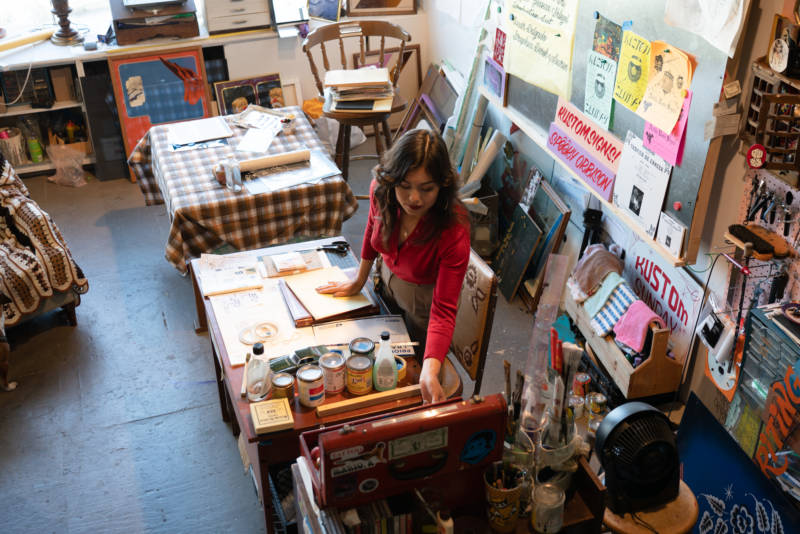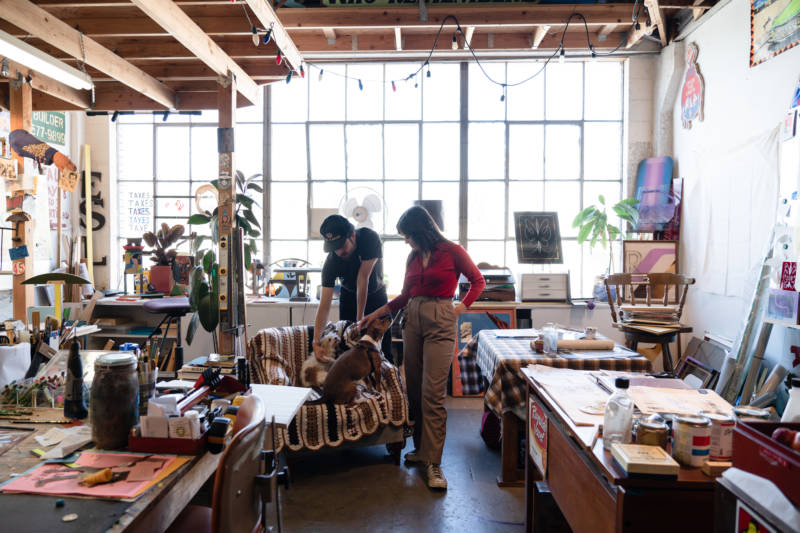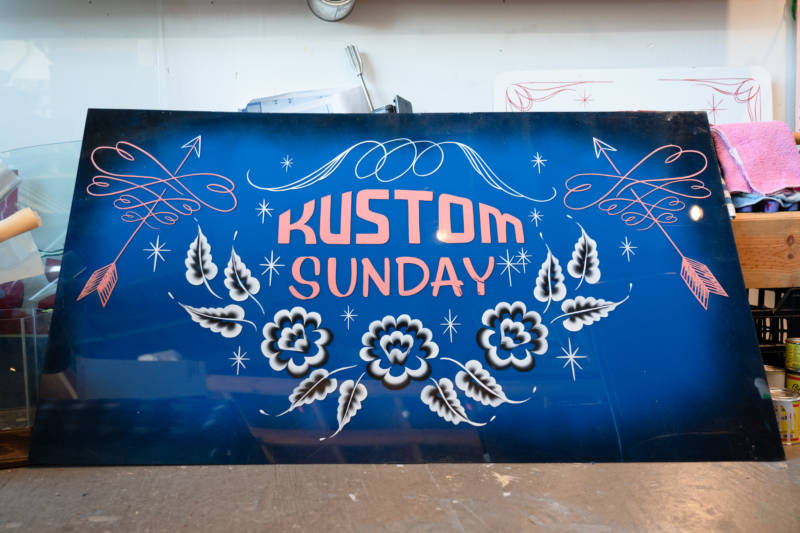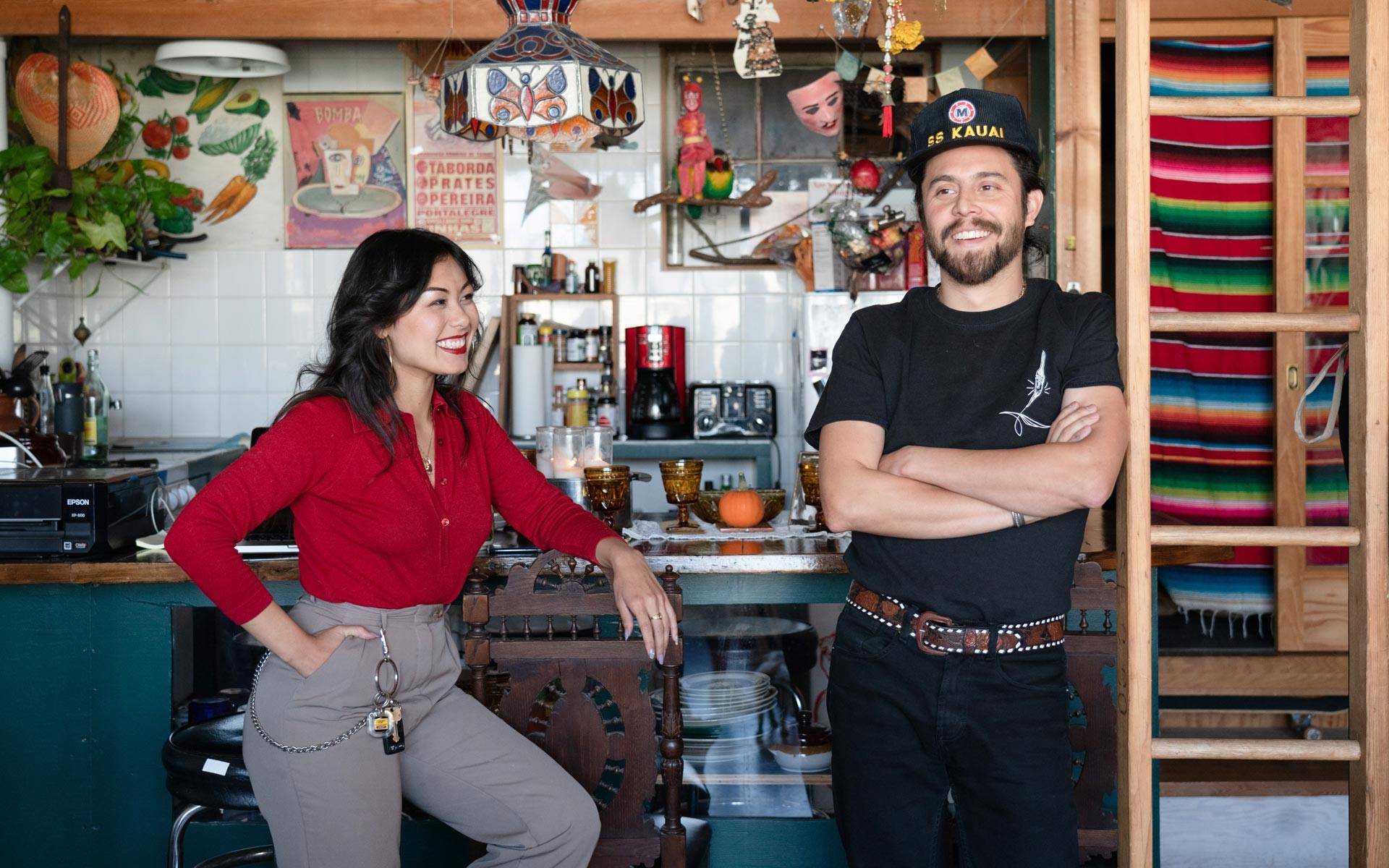It’s telling that during my visit to Isaac Avila and Lauren D’Amato’s Bernal Heights live/work space, they don’t stop painting for the entire hour we talk.
How the Money Adds Up for This San Francisco Sign-Making Couple
The couple began working together under the moniker Avila Rose Signs a year and a half ago, setting themselves up as sign painters to do the kind of work they clearly love while also carving out time for their own art practices.
“Lauren wanted to get out of the sign shop, and I wanted to do more freelance work,” Avila says. That sign shop was New Bohemia Signs, where D’Amato apprenticed while getting her degree in painting at the San Francisco Art Institute, and where she worked full-time for three-and-a-half years. (Her family also paints signs, and once had shops in Los Angeles and New Jersey: “They got me started drawing young.”)
Born in Mexico City and a graduate of UC Berkeley’s MFA program, Avila has shown paintings and sculptures in a number of local project spaces and galleries—including a recent two-person show with D’Amato at San Francisco’s Right Window Gallery—but his personal work is mostly small-scale. He wanted to make murals, but couldn’t find the right collaborator.
Enter D’Amato, raised in the lowrider hub of Whittier, who was ready to hang out her own shingle. Or, as it turned out, their shingle. “It was always my personal plan to be doing this, and when Isaac and I met and started dating, we realized there was a lot we could work on together,” D’Amato says.
As for picking up those formal sign painting skills, Avila says, “I’m still apprenticing, and will forever.”
Now they live, work and make art side-by-side in this space—a relative steal in San Francisco, with monthly rent set at $2,000. And though work by Avila Rose Signs adorns the Oakland Coliseum and countless motor vehicles currently roaming the West Coast, they’re still learning how to best advocate for their work—and deal with the financial roller coaster of running your own business.

‘We’re painting signs on a building, but we know how to use the computer!’
D’Amato rattles off a list of jobs Avila Rose Signs does: exterior signage, super graphics, gold leaf, glass work, design. “We sign paint, but we’re also more than sign painters, because there’s a lot that goes into sign painting beyond just painting a sign,” Avila explains.
Some clients don’t seem to understand that—which might have something to do with preconceived notions about the so-called “low” art of sign painting and the “high” art of graphic design work. “We’re painting signs on a building, but we know how to use the computer!” D’Amato says.
They find themselves routinely needing to make clear the true value of their labor. “Are you going to reuse this sign and is it going to become your logo? Are we choosing all the colors and aesthetics that go along with your business to the point where we’re essentially doing branding but not getting paid for that?” D’Amato asks. “We’re still trying to make sure we’re getting compensated fairly. Especially because people doing that kind of work in the city are getting paid so much more money than we’re getting paid to do a lot of the same work.”
Every job is different. Depending on the customer, the job size and their level of involvement in designing a piece, their rates vary. Each charges $80–$100 an hour (double that if they’re both working on the job), and if they’re painting a large-scale wall piece, their rates are $25–$45 per square foot. They have special sliding scales for low-income clients and neighborhood businesses.
In 2018, they painted an enormous Oakland tree logo on the exterior of the Coliseum’s newly renovated Treehouse, along with more trees inside and a giant circular sign that now hangs near a pool table. In total, they charged around $17,000 for the project, factoring in expenses like driving to and from the Coliseum, hiring a boom lift ($150–$200 per day) and splitting a third of the proceeds with a fellow sign painter. They each took home between $3,000 and $4,000, after a few weeks of preparation and four solid days of painting.

‘We’re incredibly lucky’
Like many working artists, Avila and D’Amato have a monthly income that varies widely. Avila still works two days a week bartending at the Valencia bar Mosto, and D’Amato does custom work on 45-RPM record cases, cars and motorcycles to earn a bit of side money. Every now and then D’Amato will sell artwork or embellished furniture out of the studio. Depending on how many Avila Rose jobs they line up, they make a total combined income from all jobs of between $2,000 and $5,000 a month.
In San Francisco, that isn’t much. They’re able to live off that income thanks to not only their relatively low rent, but their shared penchant for frugality.
“We’re incredibly lucky,” D’Amato says, looking around the corner of the built-out warehouse she shares with Avila. One wall faces the street, letting in light from nearly floor-to-ceiling windows. The other surfaces are covered in hand-painted signs, mementos and beautiful found objects. They sleep in a lofted area over the kitchen, and their dog Rico doesn’t take up much space.
“The group that owns this building—they’re older, at later stages in their careers,” Avila says. “And they’re all pretty aware of the hardships of just being an artist and what it takes, especially if you’re trying to build something from scratch.”
Though the fact that they’re month-to-month does bring some anxiety, D’Amato and Avila know there’s no way they could be doing what they do—getting their own business off the ground—without the support of their landlords. Paying rent on both an apartment and a separate studio, let alone one with a woodshop that would let them use enamel paints and solvents, would be prohibitively expensive.
They keep their other spending low; D’Aamato doesn’t have health insurance, and she’s slowly chipping away at her art school loans. (She transferred into SFAI, so she’s in a slightly better situation than classmates with four years of loans.) As for materials, Avila’s sculptures are made from woodshop scraps, and they both pick up old glass, furniture and frames off the streets. The materials of their sign painting trade are expensive enough—a book of gold leaf is $45–$50, pints of enamel paint run $30–$50.
“I’ll be using the same brush for like half a year, and then I’ll say, ‘I think it’s time for me to make an investment in this because it’s the thing that’s making me money,’” D’Amato says. “And then I’ll buy a few more brushes.”
How much are brushes? “Oh, probably about $20,” she laughs. “That’s how careful we are.”

‘I value all the work that we do’
Last year, Avila and D’Amato also started hosting an event series called Kustom Sunday, first at the warehouse and now at off-site locations like Golden Gate Park. For D’Amato, it’s a way to establish herself as someone who does lettering, gilding and pin-striping on cars. “That’s such a hard thing to get into, especially as a young woman,” she says. She’s perfected her own style of blended floral work most often seen on traditional furniture, and never seen in enamel paint.
At Kustom Sundays, the couple invites DJs to play, a barbeque is lit and people line up for their custom paint jobs. Similarly, if D’Amato goes to a bar and sets up shop for a night, she can make between $700 and $1,000 painting motorcycle helmets, tanks and record boxes.
Avila says it currently feels like they can’t say no to anything that pays. But D’Amato points out how important it’s been to volunteer their labor to causes and communities they believe in. In the immediate, that means considering a trip up to the Black Butte Center for Railroad Culture, where a community of sign painters periodically convenes to help restore historic railcars.
The question of why they stay in San Francisco is an easy one. For Avila, who’s been here since 2003, it’s the closest thing he has to a home. Growing up in Southern California, D’Amato spent plenty of time visiting her grandparents in the East Bay; when she finished up at SFAI, she knew she wasn’t done with the city. Despite the changes in the city’s demographics and the cost of living, they’re deeply tied to both their immediate neighborhood and the Bay Area’s artistic communities.
Merging their fine art backgrounds with the more rigid standards of sign painting, D’Amato and Avila enjoy being less traditional in their approach to Avila Rose Signs.
Or, as D’Amato puts it: “I just value all the work that we do.”


